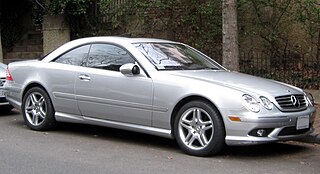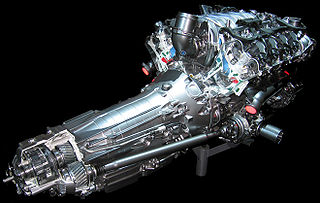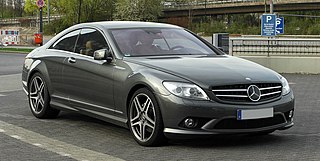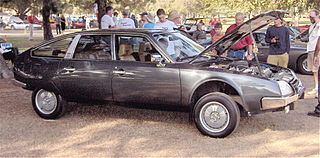
Hydropneumatic suspension is a type of motor vehicle suspension system, designed by Paul Magès, invented by Citroën, and fitted to Citroën cars, as well as being used under licence by other car manufacturers, notably Rolls-Royce, Bmw 5-Series e34 Touring, Maserati and Peugeot. It was also used on Berliet trucks and has been used on Mercedes-Benz cars, where it is known as Active Body Control. The Toyota Soarer UZZ32 "Limited" was fitted with a fully integrated four-wheel steering and a complex, computer-controlled hydraulic Toyota Active Control Suspension in 1991. Similar systems are also widely used on modern tanks and other large military vehicles. The suspension was referred to as fr:Suspension oléopneumatique in early literature, pointing to oil and air as its main components.

The Mercedes-Benz 450SEL 6.9 is the high-performance version of the W116 S-Class saloon. It was based on the long-wheelbase version of W116 chassis introduced in 1972 and equipped with Mercedes-Benz M100 V8 engine and full hydropneumatic suspension system. The 450SEL 6.9 was presented to the public at the Geneva Auto Show in 1974 as the successor to the original high-performance saloon from Mercedes-Benz, the 300SEL 6.3 (1968–1972). Like the 300SEL 6.3 before it, the special displacement number (6.9) was affixed to the trunk lid to differentiate itself from the 450SEL. The 450SEL 6.9 was produced in a very limited number from 1975 to 1981.

The Citroën Xantia, pronounced "Zan–ti–a" is a large family car (D) produced by the French automaker Citroën, and designed by Bertone. Presented to the press in December 1992, the car was produced between 1992 and 2002 in Europe, with a facelift in the end of 1997.

The Mercedes-Benz W210 was the internal designation for a range of executive cars manufactured by Mercedes-Benz and marketed under the E-Class model name in both sedan/saloon (1995–2002) and station wagon/estate (1996–2003) configurations. W210 development started in 1988, three years after the W124's introduction.

The second generation of the Mercedes-Benz CL-Class is the C215-chassis coupé of 1998–2006. It was considered by Mercedes as their premier model.

The Mercedes-Benz W220 was a range of flagship sedans which, as the fourth generation Mercedes-Benz S-Class, replaced the W140 S-Class after model year 1998 — with long and short wheelbase versions, performance and luxury options; available four-wheel drive; and a range of diesel as well as gas/petrol V6, V8, and V12 engines. Compared to its predecessor, the W220 had somewhat smaller exterior dimensions but offered greater interior volume, particularly in the long-wheelbase versions, and slightly less cargo volume.

The Mercedes-Benz W116 is a series of flagship luxury sedans produced from September 1972 until 1980. The W116 automobiles were the first Mercedes-Benz models to be officially called S-Class, although earlier sedan models had already unofficially been designated with the letter 'S' – for Sonderklasse or "special class." The W116 was selected European Car of the Year in 1974.

4Matic is the marketing name of an all-wheel drive system developed by Mercedes-Benz. It is designed to increase traction in slippery conditions. With the introduction of the 2017 E 63 S sedan, Mercedes-AMG announced a performance-oriented variant of the system called AMG Performance 4MATIC+.

The Citroën Activa and Activa 2 were two concept cars produced by the French manufacturer Citroën as a means to test and to showcase features intended for future use in their production cars. Both were unveiled at the Paris Motor Show in 1988 and 1990 respectively.

The Mercedes-Benz W221 is a chassis code of the fifth generation S-Class produced from August 2005 until June 2013. The S-Class are the flagship vehicles of Mercedes-Benz, and each generation typically introduces a range of technical innovations and developments that, over time will find their way into smaller cars.
Air suspension is a type of vehicle suspension powered by an electric or engine-driven air pump or compressor. This compressor pumps the air into a flexible bellows, usually made from textile-reinforced rubber. Unlike hydropneumatic suspension, which offers many similar features, air suspension does not use pressurized liquid, but pressurized air. The air pressure inflates the bellows, and raises the chassis from the axle.
Self-levelling refers to an automobile suspension system that maintains a constant ride height of the vehicle above the road, regardless of load.

The Mercedes-Benz C216 is the last generation for the grand tourer with name Mercedes-Benz CL-Class. It replaced the C215 platform. In 2014 it was replaced by the C217 S-Class Coupe.

Height adjustable suspension is a feature of certain automobile suspension systems that allow the motorist to vary the ride height or ground clearance. This can be done for various reasons including giving better ground clearance over rough terrain, a lower ground clearance to improve performance and fuel economy at high speed, or for stylistic reasons. Such a feature requires fairly sophisticated engineering.
An active suspension is a type of automotive suspension that uses an onboard control system to control the vertical movement of the vehicle's wheels and axles relative to the chassis or vehicle frame, rather than the conventional passive suspension that relies solely on large springs to maintain static support and dampen the vertical wheel movements caused by the road surface. Active suspensions are divided into two classes: true active suspensions, and adaptive or semi-active suspensions. While semi-adaptive suspensions only vary shock absorber firmness to match changing road or dynamic conditions, active suspensions use some type of actuator to raise and lower the chassis independently at each wheel.

The Mercedes-Benz F 200"Imagination" coupe was a concept study by then Daimler-Benz unveiled at the 1996 Paris Motor Show. The goal was to show off innovations in control, design, and comfort in passenger cars. The car's exterior design was in part based on the, then, upcoming S-Class. This 2-door coupe also previewed the CL-Class coupe, which debuted in 1999.

The Mercedes-Benz C112 was an experimental mid-engine concept car built in 1991 by German automobile manufacturer Mercedes-Benz as a test bed, similar to the later versions of the C111. Despite using the same chassis code, it was not related to the W112 series of limousines and coupes of the 1960s. The C112 was intended to be the road-legal counterpart of the Sauber-built C11 Group C prototype race car developed for the 1990 World Sports-Prototype Championship.
Sensotronic Brake Control (SBC) is an electro-hydraulic brake system, where the wheel brake cylinders on a vehicle are operated through a servomechanism.
Toyota Active Control Suspension was the world's first fully active suspension.
















